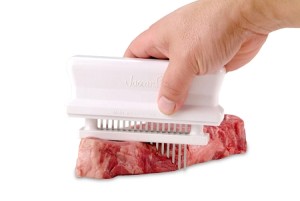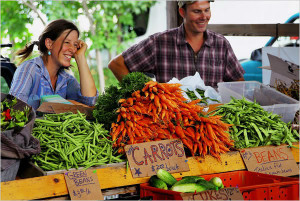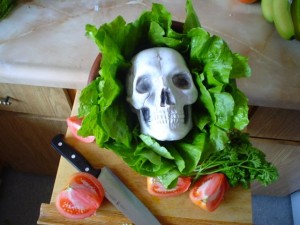The UK’s newest foodie stars, sisters Melissa and Jasmine Hemsley, purport themselves as healthy food gurus. In fact, one’s a former model, the other has a background in marketing. Following the release of their latest cookbook, experts claim their clean-eating, tongue-scraping advice could actually do more harm than good.
 Jasmine, 36, has left her racy modelling past far behind. These days, she and sister Melissa, 30, are the self-styled queens of “clean eating”, a regime that forbids followers from eating sugar, gluten and processed foods, which are said to contain body-harming toxins.
Jasmine, 36, has left her racy modelling past far behind. These days, she and sister Melissa, 30, are the self-styled queens of “clean eating”, a regime that forbids followers from eating sugar, gluten and processed foods, which are said to contain body-harming toxins.
The sisters, who have written two recipe books and set up their own cafe, can be found promoting such food fads as “spiralising”, a healthy eating gadget that turns vegetables into guilt-free “pasta”; bone broth, a collagen-rich soup made from boiling bones; and, just last week on their new UK Channel 4 TV show, astrologically farmed vegetables grown according to the cycles of the moon.
Critics say that by peddling the “clean eating” fad, the Hemsleys and their ilk – including “Deliciously” Ella Woodward – are causing vulnerable schoolgirls to become not only paranoid about food, but frightened of it.
In a society in which more young women than ever have troubled relationships with their bodies – 1.6 million people in Britain suffer from an eating disorder – this is cause for serious concern. Experts say just words such as “clean” and “cleanse” may trigger harmful behaviour.
“Clean eating uses the language of anorexics to describe food,” says Dr Richard Sly, a lecturer in mental health at the University of East Anglia. “When you place a label on such things, you are creating a judgment, one that vulnerable people will buy into.”.
The girls started tapping into Jasmine’s contacts in the TV and film world to find clients for whom they could cook healthy meals. In spring 2010, a well-known actor (whom the sisters refuse to name) asked them to help with his diet.
Before they knew it, they had a waiting list and their business was born. It was so exclusive they took on just six, super-elite clients at a time and were flown round the world as private chefs.
They set up a blog to document their work and, in 2012, it caught the attention of an editor at Vogue, who took them on as food columnists.
The Hemsley & Hemsley brand was co-founded by Jasmine’s boyfriend Nick Hopper, 40, a model and photographer, who took the pictures for their first book, The Art Of Eating Well, which has sold 150,000 copies.
Today, Jasmine and Nick live in a £585,000 flat in South-East London, while Melissa lives nearby with her boyfriend, Henry Relph, 32, a DJ and art collector.
Central to their success is their glamorous appearance and the glitzy social circles in which they move.
However, some of their dishes contain a lot of sugar – their “guilt-free” brownies have 150ml maple syrup, as well as 230g butter.
Even their “healthy” alternatives (honey, maple syrup and agave nectar) contain high levels of fructose, a natural sugar linked to diabetes, obesity and liver disease.
But most concerning of all are health ‘experts’ from whom the Hemsleys get their approach to food.
Last week, it was revealed that they support controversial diet guru Natasha Campbell-McBride, a Russian nutritionist criticised for her “Gut And Psychology Syndrome” (GAPS) doctrine, which claims that a restrictive, gluten-free diet can cure conditions including schizophrenia, autism and epilepsy. Despite not being legally registered to practise medicine in Britain, she bills herself on her UK website as “Doctor Natasha”.
Experts have branded her work “unethical” and “dangerous”, yet the Hemsleys cite her book at the top of a list of five that have “shaped their food philosophy”.
The Weston A Price Foundation, an American non-profit group founded by a dentist, is another inspiration.
Among the unorthodox practices it advocates are eating poached animal brains, feeding newborns raw cows’ milk and ingesting clay, believed to remove toxins from the body.
The sisters insist they “are not advocates of anyone else’s regime.
But leading doctor and Daily Mail columnist Max Pemberton says the doctrines they quote from are “absolute quackery”.
Their star may be on the rise, but maybe it’s time we started seeing the Hemsley sisters for what they really are: glossy beauties with an eye for making money – and not a shred of genuine expertise between them.
So is there any science behind the clean eating cult? We look at some of the most outlandish schools of thought that the Hemsleys support . . .
Biodynamic food
What is it? Based on the teachings of 19th-century Austrian philosopher Rudolf Steiner, it claims the best time to plant crops is two days before a full moon, when there is an increase in the moisture content of the soil, meaning plants “growth forces” are enhanced.
They say: In the latest episode of their cookery series, the sisters buy eggs produced by chickens fed on grain that has been “planted according to the astrological calendar”.
Liz Cotton of Orchard Eggs, the Hemsleys’ favourite biodynamic brand, explains: “The yolks are bright yellow and they taste better than organic.”
Experts say: There’s no difference – and certainly no nutritional benefit – in planting crops according to the solar system.
Dietitian Renee McGregor says some eggs are better for you than others, but this has to do with soil quality and farming conditions. “In terms of the moon, that’s a load of mumbo-jumbo,” she adds.
Tongue scraping
What is it? One of the sisters’ weirder obsessions, tongue scraping comes from Ayurvedic medicine, an ancient Indian practice.
It involves running a metal scraper – with padded handles and a sharp, curved middle – up and down your tongue to remove bacteria, fungi and food debris.
They say: “I’d rather go without brushing my teeth in the morning than not doing it,” Jasmine claims. “All your toxins come out on your tongue, so you want to remove them.”
Mindful eating
What is it? This Buddhist-inspired technique is all about taking your time over food, rather than wolfing meals down in minutes.
It encourages “reconnecting” with ingredients by paying attention to their colour, smell and texture.
They say: “If you develop a proper relationship with the food you are about to eat, it will taste better and you will feel fuller more quickly,” Jasmine claims.
They also say chewing food more slowly can “get rid of common digestive complaints”.
Experts say: It’s not complete quackery: taking time over eating can avoid indigestion and heartburn. But Jane Odgen, professor of health psychology at the University of Surrey, says this obsession with chewing “may make people over-focused on food”.
The gaps diet
What is it? Dreamed up by Russian nutritional “guru” Dr Natasha Campbell-McBride, this regime teaches that illnesses including autism, dyslexia, heart disease and epilepsy are caused by an “imbalance of intestinal flora”, which allows particles of food to escape into the blood.
GAPS – which stands for Gut And Psychology Syndrome – encourages followers to combat this by giving up sugar, dairy, starch and gluten.
They say: The Hemsleys, who cite Doctor Natasha as an influence, promote a gluten and refined sugar-free diet and warn against “leaky gut syndrome”.
Food combining
What is it? A naturopathic – in other words, not scientifically proven – theory that claims the order and combination in which you put food into your mouth can affect digestion. Also known as the Hay Diet, invented by American doctor William Howard Hay in the Thirties, it forbids eating protein and carbohydrates on the same plate.
They say: The sisters claim food combining “aids digestion and optimises nutritional absorption from our foods”.
Experts say: “There is absolutely no evidence for this,” says Renee McGregor. “Our body is capable of coping with food all on its own. It doesn’t need us interfering to help it work properly.”
Bone broth
What is it? Otherwise known as plain old stock, “bone broth” is one of the Hemsleys’ go-to recipes, made by boiling animal bones in water with vegetables, peppercorns and bay leaves for 24 hours.












